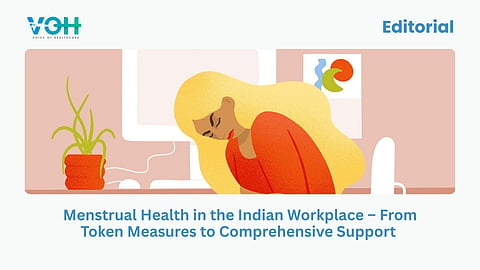

Menstrual Health as a Workplace Healthcare Priority
Menstrual health management is emerging as one of the most significant yet overlooked workplace healthcare concerns in India. With over 215 million working-age women, the need for comprehensive support is urgent. Studies suggest that up to 80% of Indian women experience menstrual pain (dysmenorrhea), and as many as one in two report missing work or school due to menstrual problems. Despite these numbers, workplace policies and infrastructure often lag behind—many employers offer little more than free pads, if anything at all.
The Unique Challenges of Menstrual Health in Indian Workplaces
1. Policy Gaps: Limited Reach of Menstrual Leave
India has no national law mandating paid menstrual leave. Only a few states—Bihar, Odisha, and Kerala—and select private companies offer such policies, ranging from two days a month to 10 annually. The vast majority of women—particularly the 95% working in the unorganized sector—receive no formal support. Even in organized workplaces like banks, police stations, and courts, more than half of women report inadequate sanitation facilities.
2. Hygiene & Product Access Challenges
While urban, higher-income women are more likely to use safe products, rural and low-income groups often rely on less hygienic methods, raising risks of infection and absenteeism. Integrated workplace education remains limited, leaving discomfort and infection common.
3. Mental Health & Stigma
Taboos around menstruation continue to affect women’s professional wellbeing. Many report heightened anxiety or withdrawal at work due to shame and lack of organizational support. Some companies and NGOs—such as The We Foundation’s Atmashakti program and Apexon’s “Happy Periods” campaign—are working to reduce stigma, but progress remains uneven, especially for marginalized women.
The Healthcare-Centric Shift: What’s Changing?
Forward-looking employers and policymakers increasingly recognize the cost of ignoring menstrual health—from lost productivity to higher healthcare expenses and attrition. This has led to:
Formal menstrual leave policies in select companies (Zomato, Culture Machine, Byju’s) and state governments.
Partnerships with medical providers for health camps, pain management, and screening of menstrual disorders—moving beyond a “pad-only” approach.
Improved infrastructure in some workplaces: clean restrooms, disposal bins, reliable water access, and reproductive health resources.
Evidence & Impact
Up to 80% of Indian women experience dysmenorrhea.
Around 40% experience premenstrual symptoms affecting work and mood.
Up to half of women report missing work or school due to menstrual issues, with higher rates in rural and informal sectors.
Absenteeism decreases where menstrual leave exists—for example, Bihar’s “biological leave” policy.
Corporate programs are linked with higher job satisfaction and retention (up to 25%).
Rural interventions such as Project Shakti have reduced period-related absences by nearly 45%.
More than 60% of female healthcare workers report compromising on menstrual hygiene due to poor facilities and demanding schedules.
Case Studies: Innovations in Menstrual Health
Global Perspective
Globally, countries such as Japan (since 1947), Spain (2023), and Indonesia already provide menstrual leave. India, while ahead in some corporate-led initiatives, still lacks a national framework—leaving most women outside formal protections.
Conclusion: India’s Road Ahead
Menstrual health in the workplace lies at the intersection of healthcare, gender equity, and productivity. Addressing it requires systemic reform, stronger workplace infrastructure, and an end to stigma and silence. By moving beyond token measures to comprehensive, inclusive support, India can create healthier, more empowered workers—and strengthen its economic and social fabric.